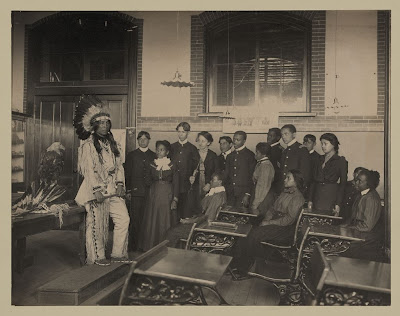I would like to dedicate this post to former student and colleague Stacy Williams who first introduced me to the Hampton Album and Frances Benjamin Johnston's photographs. Also, I would like to thank student Fabienne Snowden for drawing my attention to articles on Hampton photographs by Jeannene M. Przyblyski and Ramona Austin.
This particular set of photographs was first widely seen as a result of an exhibition curated by John Szarkowski, Curatorial Director of Photography at the Museum of Modern Art in New York in 1966. The source of the 60 or so featured photographs was a much larger scrapbook of 150 photographs purchased by Lincoln Kirsten in a secondhand bookstore in Washington, D.C. some time before. It seemed very much as though the scrapbook, one of the three which were known to still exist--the other two at the Library of Congress in the Frances Benjamin Johnston Collection of Photographs and as part of the photographic collection of Hampton University--had come into being as a form of illustrating to perspective sponsors the range of programs at the institution. Johnston charged $1000 for the services of herself and her assistant, who was apparently her mother. She spent the month of December 1899 as well as some of January carefully executing the job, during which she extensively photographed both African American and Native American students and white instructors at Hampton.
In one photograph, which helps to give you a true sense of the scope of the project, Johnston photographs the entire student body and faculty assembled in a major hall at Hampton. All the photographs were no doubt taken with available light and with long exposures which would have required that subjects maintain their pose for a period of time, thus accounting for the precise almost clinical angularity of many of the images. The people in the pictures figure little as emotional individuals (causing some to read the photographs only in terms of the racism of the conditions that produced them). Yet the youthful vigor, beauty and intelligence of the people in the pictures is superbly illustrated. The human face and body is, itself, a form of expression virtually impossible to suppress or denature.
The exhibition catalogue was named The Hampton Album, now out-of-print but widely available in the second-hand book market online (http://www.abe.com). These photographs we learned were taken by Frances Benjamin Johnston, a white female photographer who took many pictures of Native American and African American institutions of learning around the turn-of-the-century, as well as photographs of the Washington elite including the family of then president Theodore Roosevelt. Later she would become better known as a photographer of architecture but around the turn of the century, her photography frequently implies particular associations with the racial politics of the period, as one can gather from the writings of a range cultural history scholars about her.

"About 400 Students in Memorial Chapel" in 1900.

"John Wizi, Sioux. Son of Chief Wizi of Crow Creek, S.D." as cited in The Hampton Album.
But my immediate interest is in her photographs of educational practices at the turn-of-the-century, and in particular her photographs of the Hampton Institute (the school that Booker T. Washington attended), Tuskegee (the school Washington created), and the Carlisle Indian School. To see these photographs, to observe their quiet beauty and discipline is to partake something of the difficulties encountered by attempts to educated the children of the former slaves. Not only did Johnston document the programs of these institutions for all time but further, apparently her work as a photographer inspired programs in photography at both Hampton and Tuskegee. At Hampton Johnston's presence coincided with the early activity of a group of faculty who called themselves the Hampton Camera Club, and who subsequently illustrated many issues of The Southern Workman (the house publication of Hampton) as well as several books by Paul Lawrence Dunbar, a famous African American poet at the turn-of-the-century. At Tuskegee, Johnston no doubt helped to inspire the founding of a photography program at Tuskegee. Washington seems to have been acutely aware of the potential educational and propaganda value of photography and of black photographers.
When we turn to the pivotal figure of WEB Du Bois, we find someone who organized a major exhibition of photography known as the "Negro Exhibition" to represent the advances and conditions of African Americans at the Paris Exposition in 1900. He would also use photography extensively in his campaign for the dignity of African Americans as editor of The Crisis, the publication of the NAACP (National Association for the Advancement of Colored People).

"About 400 Students in Memorial Chapel" in 1900.

"John Wizi, Sioux. Son of Chief Wizi of Crow Creek, S.D." as cited in The Hampton Album.
Young Native American student (in traditional dress in other photograph) with conventional haircut and dress at Hampton 1900, Library of Congress.
"Geography. Studying the Seasons." Hampton 1900.
REFERENCES:
Bettina Berch, The Woman behind the Lens: The Life and Work of Frances Benjamin Johnston, 1864-1952. Charlottesville and London: The University Press of Virginia, 2000.
Max Bennett Thrasher, Tuskegee: Its Story and Its Work (1900), North Stratford, NH: Ayer Company Publishers, Inc. Reprint Edition 2000.
James Anderson, The Education of Blacks in the South, Chapel Hill, NC: University of North Carolina Press, 1988.
The Hampton Album, 44 Photographs by Frances B. Johnston from an album of Hampton Institute with an introduction and a note on the photographer by Lincoln Kirstein, The Museum of Modern Art, New York 1966.
Jeannene M. Przyblyski, "American Visions at the Paris Exposition, 1900: Another Look at Frances Benjamin Johnston's Hampton Photographs," Art Journal, Vol. 57, No. 3 (Autumn 1998), pp. 61-68. College Art Association. http://www.jstor.org/stable/777972
Ramona Austin, "An Extraordinary Generation; The Legacy of William Henry Sheppard, The 'Black Livingstone' of Africa," Afrique & Histoire 2000 no. 4, 74-101.




